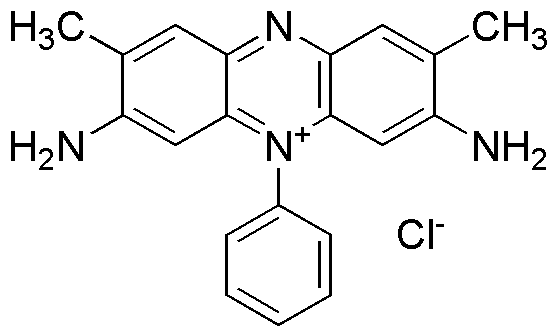Safranine O Certified is widely utilized in research focused on:
- Biological Staining: This compound is commonly used in histology and microbiology for staining tissues and cells, allowing researchers to visualize cellular structures under a microscope. Its vibrant color enhances contrast, making it easier to identify specific cell types.
- Redox Indicator: In analytical chemistry, it serves as a redox indicator due to its ability to change color depending on the oxidation state. This property is particularly useful in titrations and other quantitative analyses.
- Fluorescent Probes: Safranine O is employed as a fluorescent probe in various biochemical assays, enabling the detection of biomolecules with high sensitivity. This application is crucial in drug discovery and molecular biology research.
- Environmental Monitoring: The compound is used in environmental studies to assess the presence of pollutants, particularly in water samples. Its ability to bind to certain contaminants makes it a valuable tool for environmental scientists.
- Textile Industry: In the textile sector, it acts as a dye for fabrics, providing rich color and durability. Its application in this industry highlights its versatility beyond laboratory settings.
General Information
Properties
Safety and Regulations
Applications
Safranine O Certified is widely utilized in research focused on:
- Biological Staining: This compound is commonly used in histology and microbiology for staining tissues and cells, allowing researchers to visualize cellular structures under a microscope. Its vibrant color enhances contrast, making it easier to identify specific cell types.
- Redox Indicator: In analytical chemistry, it serves as a redox indicator due to its ability to change color depending on the oxidation state. This property is particularly useful in titrations and other quantitative analyses.
- Fluorescent Probes: Safranine O is employed as a fluorescent probe in various biochemical assays, enabling the detection of biomolecules with high sensitivity. This application is crucial in drug discovery and molecular biology research.
- Environmental Monitoring: The compound is used in environmental studies to assess the presence of pollutants, particularly in water samples. Its ability to bind to certain contaminants makes it a valuable tool for environmental scientists.
- Textile Industry: In the textile sector, it acts as a dye for fabrics, providing rich color and durability. Its application in this industry highlights its versatility beyond laboratory settings.
Documents
Safety Data Sheets (SDS)
The SDS provides comprehensive safety information on handling, storage, and disposal of the product.
Product Specification (PS)
The PS provides a comprehensive breakdown of the product’s properties, including chemical composition, physical state, purity, and storage requirements. It also details acceptable quality ranges and the product's intended applications.
Certificates of Analysis (COA)
Search for Certificates of Analysis (COA) by entering the products Lot Number. Lot and Batch Numbers can be found on a product’s label following the words ‘Lot’ or ‘Batch’.
*Catalog Number
*Lot Number
Certificates Of Origin (COO)
This COO confirms the country where the product was manufactured, and also details the materials and components used in it and whether it is derived from natural, synthetic, or other specific sources. This certificate may be required for customs, trade, and regulatory compliance.
*Catalog Number
*Lot Number
Safety Data Sheets (SDS)
The SDS provides comprehensive safety information on handling, storage, and disposal of the product.
DownloadProduct Specification (PS)
The PS provides a comprehensive breakdown of the product’s properties, including chemical composition, physical state, purity, and storage requirements. It also details acceptable quality ranges and the product's intended applications.
DownloadCertificates of Analysis (COA)
Search for Certificates of Analysis (COA) by entering the products Lot Number. Lot and Batch Numbers can be found on a product’s label following the words ‘Lot’ or ‘Batch’.
*Catalog Number
*Lot Number
Certificates Of Origin (COO)
This COO confirms the country where the product was manufactured, and also details the materials and components used in it and whether it is derived from natural, synthetic, or other specific sources. This certificate may be required for customs, trade, and regulatory compliance.


